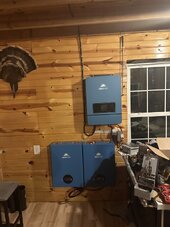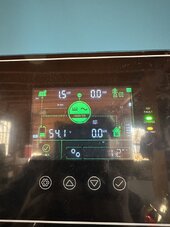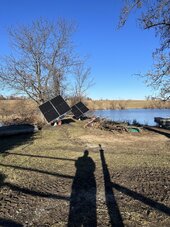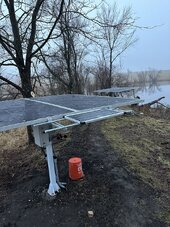Flatpicker
New Member
Hello All.
I’ve been fortunate enough to have found this forum just as my panels, mounts, inverter and batteries arrived. That said, I was committed to the equipment as I ordered it - might have made a change or two in retrospect, especially after some digging thru the wealth of knowledge here.
Here’s what I’ve got:
(4) 550 Watt Bifacial panels. 50.1 VOC
(2) EcoWorthy dual axis tracking mounts
(2) Sungold 5.1 kW LiFe Phosphate wall mount batteries
(1) Sungold 8 kW split phase inverter (dual MPPT inputs, 500 volts max)
My goal was to be generating at the worst time of year for solar production (i.e. Winter solstice) and I nearly made that by generating on the 29th of December. The highest input I’ve seen from the 4 panels (wired in series) was 1.5 kW and so far I have produced about 20 kW according to my inverter. Production is obviously hit or miss and my main objective was to get both batteries up to 95% SOC before putting a load on them so I could calculate real world “worst case” runtime.
I have a 9000 BTU Senville split unit, a 1953 Philco refrigerator, and LED lights throughout the cabin. Total load with everything running is just under 1000 watts, so I’m thinking I’ve got a good 7.5 hours from 95% SOC down to 20% SOC. Would like to add more batteries (I’ve ordered two more 5.1 kW wall mounts), but this brings up the question: Should I add more panels?
Which brings up the NEXT question: I’m only using one MPPT input with input voltage running about 180 VDC from the four panels in series - do I add another four panels on the other MPPT input or series them with the input being used to boost the voltage to about 360 VDC? Is the inverter more efficient with one input of 360 volts or with two at 180?
Your feed back is much appreciated!



I’ve been fortunate enough to have found this forum just as my panels, mounts, inverter and batteries arrived. That said, I was committed to the equipment as I ordered it - might have made a change or two in retrospect, especially after some digging thru the wealth of knowledge here.
Here’s what I’ve got:
(4) 550 Watt Bifacial panels. 50.1 VOC
(2) EcoWorthy dual axis tracking mounts
(2) Sungold 5.1 kW LiFe Phosphate wall mount batteries
(1) Sungold 8 kW split phase inverter (dual MPPT inputs, 500 volts max)
My goal was to be generating at the worst time of year for solar production (i.e. Winter solstice) and I nearly made that by generating on the 29th of December. The highest input I’ve seen from the 4 panels (wired in series) was 1.5 kW and so far I have produced about 20 kW according to my inverter. Production is obviously hit or miss and my main objective was to get both batteries up to 95% SOC before putting a load on them so I could calculate real world “worst case” runtime.
I have a 9000 BTU Senville split unit, a 1953 Philco refrigerator, and LED lights throughout the cabin. Total load with everything running is just under 1000 watts, so I’m thinking I’ve got a good 7.5 hours from 95% SOC down to 20% SOC. Would like to add more batteries (I’ve ordered two more 5.1 kW wall mounts), but this brings up the question: Should I add more panels?
Which brings up the NEXT question: I’m only using one MPPT input with input voltage running about 180 VDC from the four panels in series - do I add another four panels on the other MPPT input or series them with the input being used to boost the voltage to about 360 VDC? Is the inverter more efficient with one input of 360 volts or with two at 180?
Your feed back is much appreciated!






